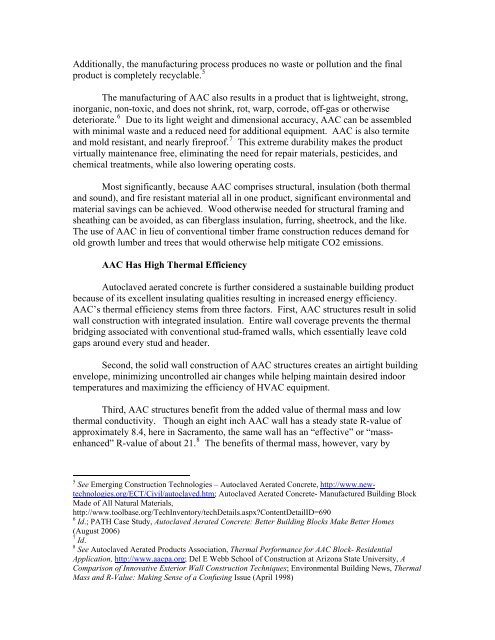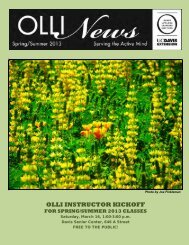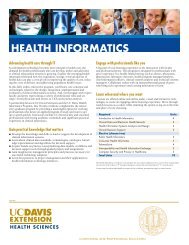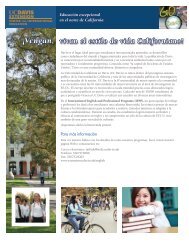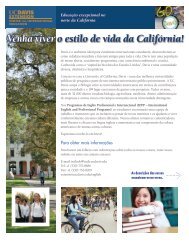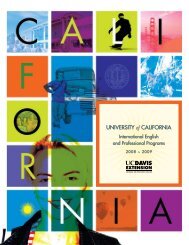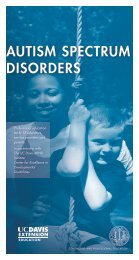Autoclaved aerated concrete - UC Davis Extension
Autoclaved aerated concrete - UC Davis Extension
Autoclaved aerated concrete - UC Davis Extension
Create successful ePaper yourself
Turn your PDF publications into a flip-book with our unique Google optimized e-Paper software.
Additionally, the manufacturing process produces no waste or pollution and the final<br />
product is completely recyclable. 5<br />
The manufacturing of AAC also results in a product that is lightweight, strong,<br />
inorganic, non-toxic, and does not shrink, rot, warp, corrode, off-gas or otherwise<br />
deteriorate. 6 Due to its light weight and dimensional accuracy, AAC can be assembled<br />
with minimal waste and a reduced need for additional equipment. AAC is also termite<br />
and mold resistant, and nearly fireproof. 7 This extreme durability makes the product<br />
virtually maintenance free, eliminating the need for repair materials, pesticides, and<br />
chemical treatments, while also lowering operating costs.<br />
Most significantly, because AAC comprises structural, insulation (both thermal<br />
and sound), and fire resistant material all in one product, significant environmental and<br />
material savings can be achieved. Wood otherwise needed for structural framing and<br />
sheathing can be avoided, as can fiberglass insulation, furring, sheetrock, and the like.<br />
The use of AAC in lieu of conventional timber frame construction reduces demand for<br />
old growth lumber and trees that would otherwise help mitigate CO2 emissions.<br />
AAC Has High Thermal Efficiency<br />
<strong>Autoclaved</strong> <strong>aerated</strong> <strong>concrete</strong> is further considered a sustainable building product<br />
because of its excellent insulating qualities resulting in increased energy efficiency.<br />
AAC’s thermal efficiency stems from three factors. First, AAC structures result in solid<br />
wall construction with integrated insulation. Entire wall coverage prevents the thermal<br />
bridging associated with conventional stud-framed walls, which essentially leave cold<br />
gaps around every stud and header.<br />
Second, the solid wall construction of AAC structures creates an airtight building<br />
envelope, minimizing uncontrolled air changes while helping maintain desired indoor<br />
temperatures and maximizing the efficiency of HVAC equipment.<br />
Third, AAC structures benefit from the added value of thermal mass and low<br />
thermal conductivity. Though an eight inch AAC wall has a steady state R-value of<br />
approximately 8.4, here in Sacramento, the same wall has an “effective” or “massenhanced”<br />
R-value of about 21. 8 The benefits of thermal mass, however, vary by<br />
5<br />
See Emerging Construction Technologies – <strong>Autoclaved</strong> Aerated Concrete, http://www.newtechnologies.org/ECT/Civil/autoclaved.htm;<br />
<strong>Autoclaved</strong> Aerated Concrete- Manufactured Building Block<br />
Made of All Natural Materials,<br />
http://www.toolbase.org/TechInventory/techDetails.aspx?ContentDetailID=690<br />
6<br />
Id.; PATH Case Study, <strong>Autoclaved</strong> Aerated Concrete: Better Building Blocks Make Better Homes<br />
(August 2006)<br />
7<br />
Id.<br />
8<br />
See <strong>Autoclaved</strong> Aerated Products Association, Thermal Performance for AAC Block- Residential<br />
Application, http://www.aacpa.org; Del E Webb School of Construction at Arizona State University, A<br />
Comparison of Innovative Exterior Wall Construction Techniques; Environmental Building News, Thermal<br />
Mass and R-Value: Making Sense of a Confusing Issue (April 1998)


